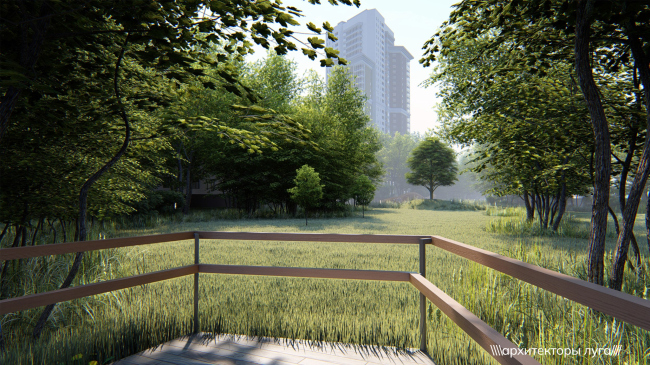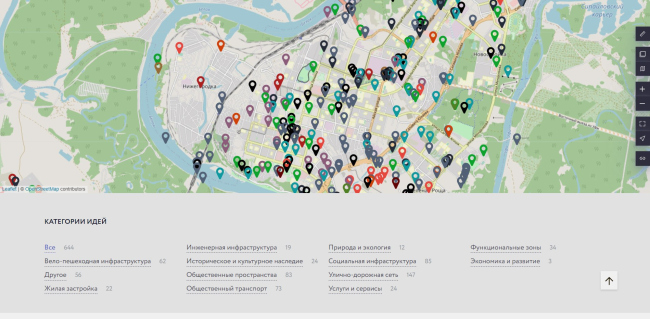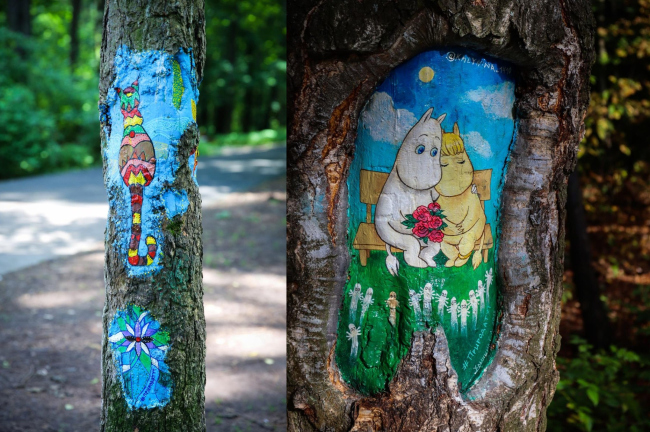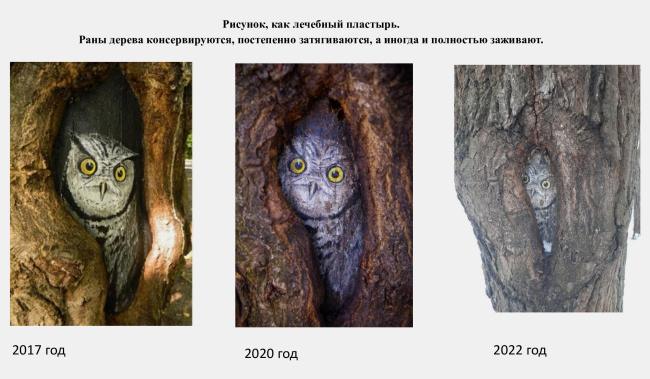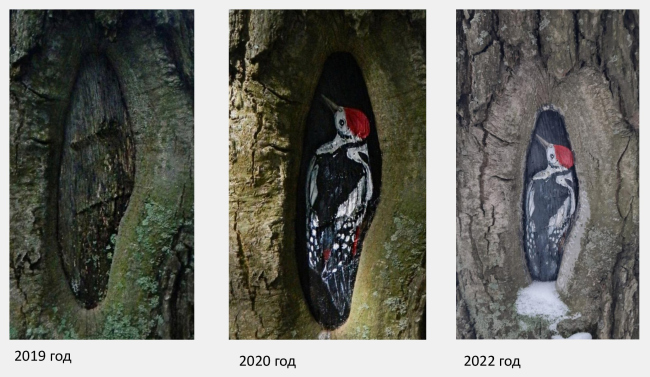|
Published on Archi.ru (https://archi.ru) |
|
| 10.10.2022 | |
|
Three “Green” Stories |
|
|
Darya Gorelova |
|
| Studio: | |
| Genplan Institute of Moscow | |
|
In this issue, we are examining three environmental urban projects showcased by the Genplan Institute of Moscow at the Zodchestvo festival. The scale of the projects is really diverse: from gathering information and suggestions from the residents on a city scale to growing meadow grass between houses to paintings, which, as it turned out, possess power to cure trees, healing their wounded bark. + a list of kinds of plants natural for Moscow to help the developer. At the Zodchestvo festival, the Genplan Institute of Moscow conducted a discussion named “The city’s environmental well-being: a path to sustainable development”. Making a recap, one can say: it was about how to (a) help wildlife and some of its specific representatives to survive within the city boundaries and (b) raise the city people’s spirits. Or how the city people can learn to preserve and reproduce wildlife in the context of a man-made environment and be happy to live next to it. Here is the thing – the wildlife that you can see in a megalopolis is by no means limited by cats and pigeons.  Arseniy Penkin, Head of the Marketing Department of Genplan Institute of Moscow Today, ecology is usually talked about from the perspective of ESG (analytical index that stands for environmental, social, governance, – ed.) However, this is more of a commercial approach. We invited the experts to talk about some applied and more understandable things as part of the discussion: how to preserve and multiply the natural resources that already exist in the city. Moscow is one of the world’s greenest megalopolises; almost all kinds of natural territories are represented here. In this city, you can meet not just pets, but also representatives of wildlife as well. The question is how to preserve these riches, how to handle them, how to take them into account in the new design, when creating comfortable territories. In general, how to protect those participants in biological life who cannot say anything for themselves. We picked the three most interesting projects and we are sharing with you about them. A Lawn by the House Arkhitektory Luga (“Meadow Architects”) Nadezhda Astanina, Anna Antokhina, Nadezhda Kiyatkina, Aleksey Levchenko Ecopark Sacred Meadow in the Academichesky District. Project, 2017Copyright: © Meadow ArchitectsThe team, which formed in 2017, when the architects were working on a landscaping project for a large site in Moscow’s Akademichesky district, was represented by Anna Antokhina. The landscape architects position themselves as “Russia’s first nature-focused design team”. This, however, is something that is hard to believe because such bold statements need proof. But the showcased examples are really inspiring, even if painfully small. Number one: a little park – let’s call it that – with an area of 3 hectares, on Ivana Babushkina Street, situated behind the Darwin Museum. According to the architects, the land site got vacated because it was cleared of old garages standing on it, and the city proposed to make a boulevard here. Instead of the habitual urban plants, Meadow Architects proposed to foster natural meadow plants here, which is how the name of the team came about. In addition, the architects design low curbs, which tiny animals could climb over, and “wedging seams”, through which insects could travel across “extensively paved areas” – yes, there are paved areas in the project too. However, when it comes to the presence of human beings, the authors try to minimize it, limiting it to sightseeing terraces, so as to make sure that the human factor gets as little as possible in the way of natural development of the ecosystem.  Ecopark Sacred Meadow in the Academichesky District. Project, 2017Copyright: © Meadow Architects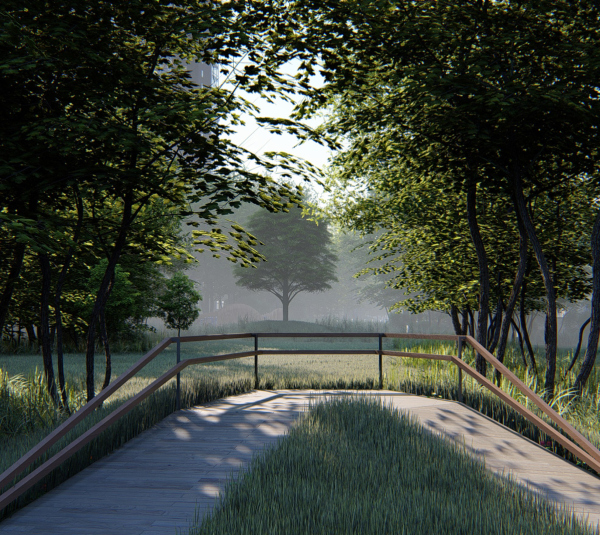 Ecopark Sacred Meadow in the Academichesky District. Project, 2017Copyright: © Meadow Architects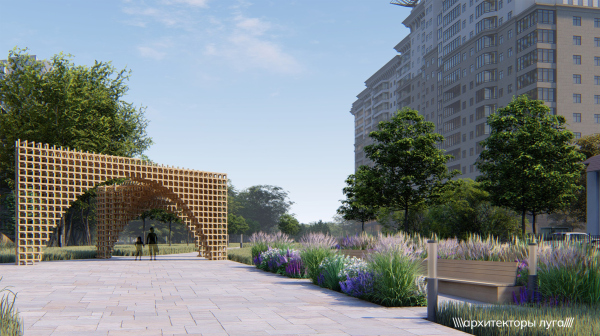 Ecopark Sacred Meadow in the Academichesky District. Project, 2017Copyright: © Meadow Architects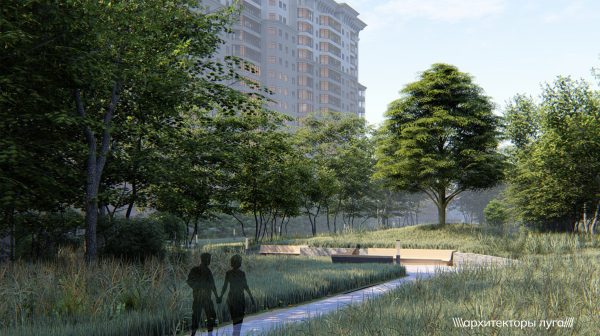 Ecopark Sacred Meadow in the Academichesky District. Project, 2017Copyright: © Meadow Architects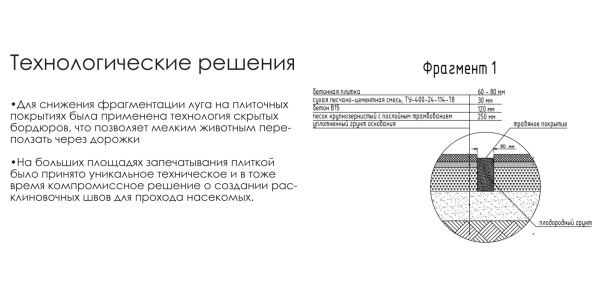 Ecopark Sacred Meadow in the Academichesky District. Project, 2017Copyright: © Meadow ArchitectsThe project was not implemented. However, the Yandex maps display the specific name of Zapovedny Lug (“Sacred Meadow”). The architects collected 3000 signatures from the residents who backed up their proposal. They also received a few awards, and showcased their project in Sorbonne. More remarkably, however, over the recent time, biocoenosis has developed all on its own. On the territory, the biologists discovered up to 600 species, 20 of which are considered to be endangered. Another example – also located in the Akademichesky district – has been implemented. It is smaller, though. The architects offered the residents to turn their rank-and-file lawn into a meadow, and not just any meadow but one with a year-round flourish. What it ended up being is essentially a mini park with an educational potential because there are signs with the name of the plants. This is a typical “small deeds” approach at the junction of landscape, biology, and participating. 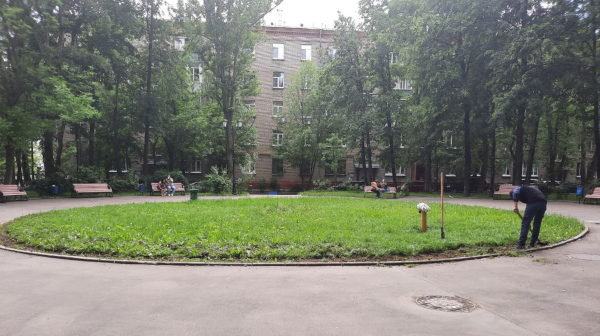 Mini-garden in the Academichesky District. Implemented, 2017Copyright: © Meadow Architects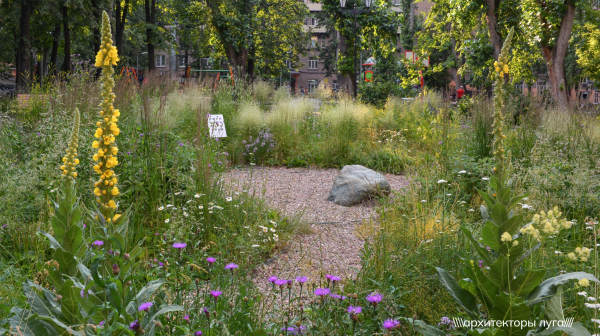 Mini-garden in the Academichesky District. Implemented, 2017Copyright: © Meadow Architects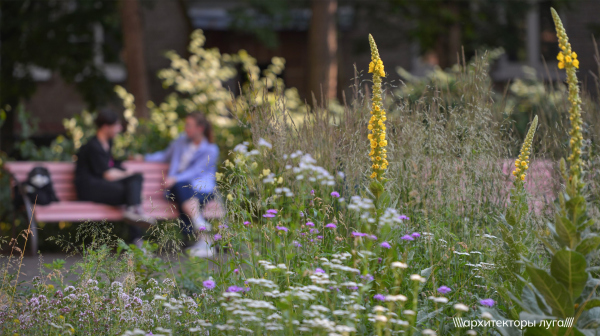 Mini-garden in the Academichesky District. Implemented, 2017Copyright: © Meadow ArchitectsThe main message from Meadow Architects is that you can and even must cultivate the plant species natural for these latitudes in a big city: they also take root better, they should be allowed to grow, they should not be mown ahead of time (July 15), they are stable, diverse and attract friendly small animals and insects to symbiosis. From the report we learned, among other things, that the Monarch Butterfly exists in symbiosis with silkweed, the Nettle Butterfly brings out its caterpillars on stinging nettles (big surprise), and the bee called Melita Dentata pollinates only “Sawtooth Grass” (another surprise). Here is the most interesting thing, though: Meadow Architects created – to help the developers – a list of plants indigenous to Moscow and St. Petersburg. It is available online at greenzoom.ru (the Russian system of green certification). Developing local plants on their territories, the developers improve their chances of receiving the “green standard” certificate. Eco-diagnostics Irina Ivashkina Candidate of Geographical Sciences, ecologist, head of the sector for the informational and analytical support of territorial planning for the Genplan Institute of Moscow. The vision presented in the Irina Ivashkina presentation is the most large-scale of the three, yet at the same time it is also participation-based, and is connected with working with the local population. Here it is not about a little park or a lawn but about planning the ecological well-being of large cities on the master plan level. Examples of this were: the environmental diagnostics of Moscow and Ufa 2009 – the analytic research that preceded the development of the city’s master plan. The latest project is quite recent – the master plan of Ufa was adopted in 2022. 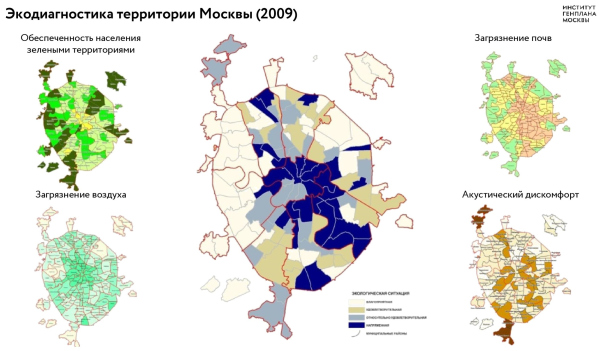 Ecodiagnostics of the territory of Ufa. 2020-2021. Fragment of Irina Ivashkina′s presentationCopyright: © Genplan Institute of Moscow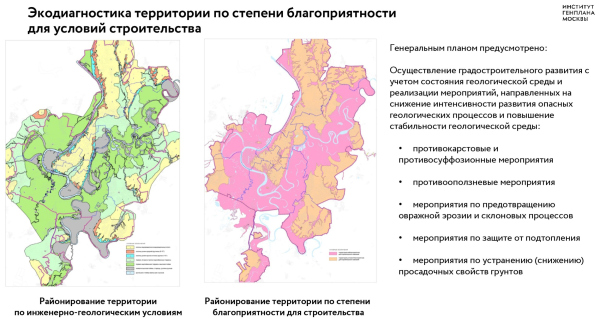 Ecodiagnostics of the territory of Ufa. 2020-2021. Fragment of Irina Ivashkina′s presentationCopyright: © Genplan Institute of Moscow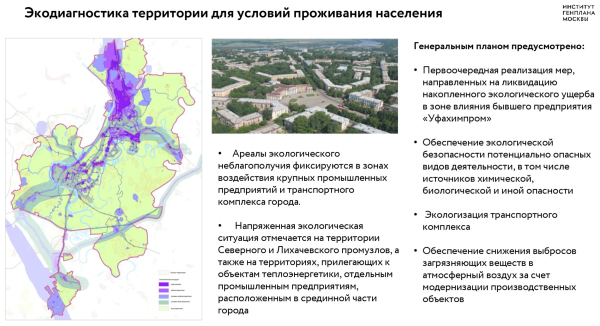 Ecodiagnostics of the territory of Ufa. 2020-2021. Fragment of Irina Ivashkina′s presentationCopyright: © Genplan Institute of Moscow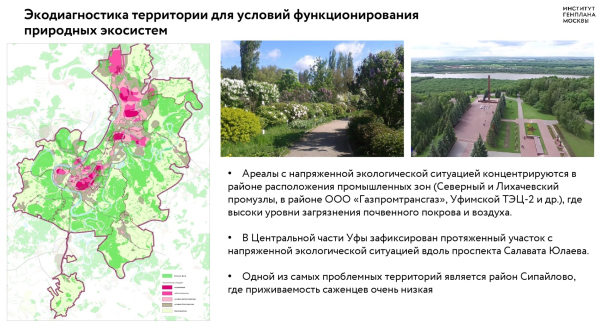 Ecodiagnostics of the territory of Ufa. 2020-2021. Fragment of Irina Ivashkina′s presentationCopyright: © Genplan Institute of MoscowAn important part of working on the environmental assessment of territories – apart from “big data” and specialized archives is the actual gathering of “live” information and communication with local residents. However, since we are talking about large cities, this “pinpoint” work, although sometimes relevant, is not always effective. This is why the Genplan Institute of Moscow – an organization that is focused on solving large-scale tasks by chiefly technology-based methods – developed an interactive map for interacting with the residents of those cities, the master plans for which are developed by the Genplan Institute of Moscow. The map is available at and is used for the collection of data on relevant projects. Currently, the project involves Ekaterinburg, Yuzhno-Sakhalinsk, and Ufa. Interactive map of city development ideasCopyright: © Genplan Institute of MoscowUfa. Interactive map of city development ideasCopyright: © Genplan Institute of MoscowUfa. Interactive map of city development ideasCopyright: © Genplan Institute of MoscowA Painting on a Tree Dmitry Voitovic, Head of the agency for environmental education and animal tracking of GBPU “Mospriroda” Environmental action “ParkArt”Copyright: © MosprirodaIn our opinion, the most interesting part of this story was the one about painted trees. Many of you have probably seen such paintings – executed in the naivety spirit, with different degrees of detailing, but bright and cute in their own way – in the city parks. Turned out, it was a centralized project staged by Mospriroda and called “ParkArt”: it started back in 2015 in Izmailovsky Park; over the 7 years that have elapsed l, about 250 pictures have been painted on trees. 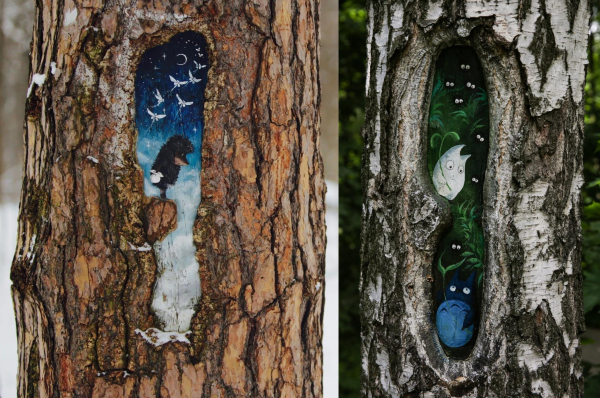 Environmental action “ParkArt”Copyright: © Mospriroda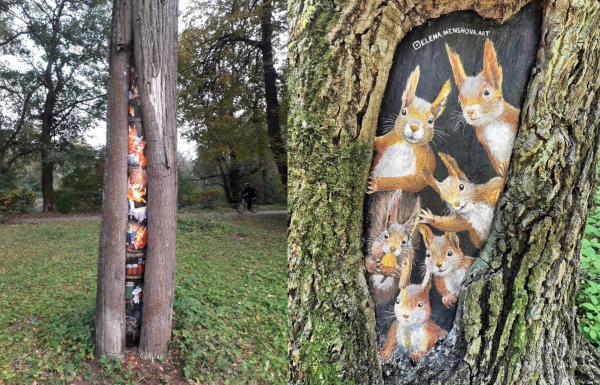 Environmental action “ParkArt”Copyright: © Mospriroda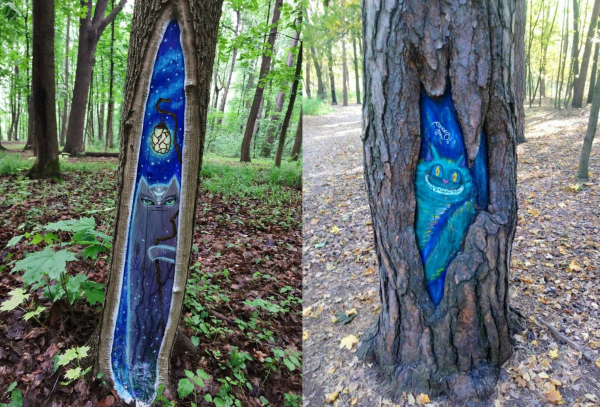 Environmental action “ParkArt”Copyright: © Mospriroda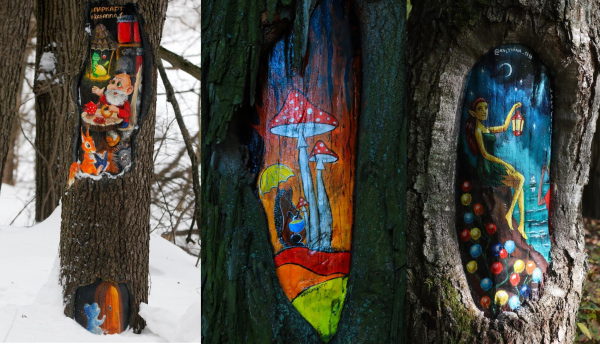 Environmental action “ParkArt”Copyright: © MosprirodaAll of this, as we said, is rather cute, but it is a different thing that matters: these paintings are not really about beauty – they cure the trees not in the figurative, but in the mist literal sense as can be. The “wound” – the place where the wood tissue is devoid of bark and is bare – is first treated with a special solution, and then is covered with acrylic paints. As a result, the tree starts gradually “healing” the bark damage: the process that took place within a couple of years, is quite tangible. Environmental action “ParkArt”Copyright: © MosprirodaEnvironmental action “ParkArt”Copyright: © MosprirodaDuring the discussion, an opinion was voiced from the audience that originally this idea was proposed by a Moscow artist – somehow, nobody was able to recall her name- and then picked up by Mospriroda. Well, they did well to pick it up. Essentially, to heal the cracks in the bark, you can just treat them with a special solution and then cover them with paint – but the pictures do give them a lively look. The pictures get shortlisted and approved; the artists work on a voluntary basis but they are allowed to mark their work with links to their socials. |
|
